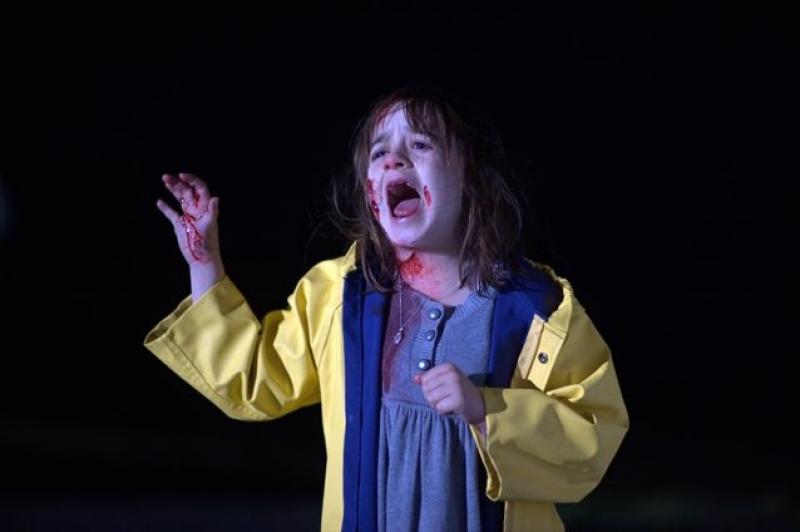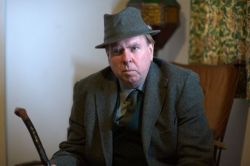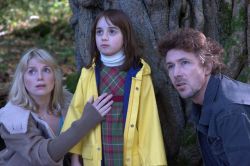Wake Wood | reviews, news & interviews
Wake Wood
Wake Wood
Hammer horror, itself back from the dead, is a spooky tale of corpse revival

In Wake Wood, Aidan Gillen and Eva Birthistle play a married couple who lose their nine-year-old daughter in horrific circumstances. In mainstream cinema, this would lead to the earnest soul-searching and Oscar-bait performances of films like In the Bedroom, The Door in the Floor or Rabbit Hole.
In Wake Wood, Aidan Gillen and Eva Birthistle play a married couple who lose their nine-year-old daughter in horrific circumstances. In mainstream cinema, this would lead to the earnest soul-searching and Oscar-bait performances of films like In the Bedroom, The Door in the Floor or Rabbit Hole. But Wake Wood is the latest film from the new-model Hammer Film Productions. Which of course means the soul-searching is followed by lots of running, and screaming, and blood.
The loss of a child – and the consequences of misguided parental attempts to deal with that loss - is a recurrent theme in horror movies. The most agonising examples are Nicolas Roeg’s 1973 chiller Don’t Look Now, adapted from a story by Daphne du Maurier, and Mary Lambert’s 1989 adaptation of the Stephen King novel Pet Sematary, which was pretty much dismissed on initial release but has since garnered something of a following.
Wake Wood cleaves more to Pet Sematary than to Don’t Look Now, with an attempt at corpse revival in the best tradition of WW Jacobs’s seminal 1902 short story The Monkey’s Paw, in which the eponymous object "had a spell put on it by an old fakir" who "wanted to show that fate ruled people's lives, and that those who interfered with it did so to their sorrow".
Birthistle and Gillen install themselves in the small Irish village of Wake Wood (played by the border town of Pettigo, County Donegal) in an attempt to come to terms with their loss; he's a vet, she's a pharmacist. It also happens to be the only place in the British Isles with the means to raise the dead, which puts the kibosh on their grieving process and replaces it with deluded hope. Arcane pagan rituals are practised, but despite some superficial similarities, this is no Wicker Man community; the villagers, led by Timothy Spall (with underplayed Irish accent) as the local squire, appear to be well-meaning, and play by a stringent set of rules. The dead can be raised for three days only, giving their loved ones a chance to say the goodbyes they were denied in life.
 Unfortunately, Gillen and Birthistle are so desperate to have their daughter back they break the rules, with the sort of catastrophic consequences that anyone familiar with, say, the aforementioned Pet Sematary can predict. But let's just say that young Ella Connolly shows a nice line in Damien-esque menace, with the costume department ringing the changes on that Don't Look Now red raincoat by equipping her with a yellow slicker, which may itself remind diehard horror fans of Alfred Sole's 1976 shocker Communion, also known as (appropriately, given the name of Connolly's character) Alice, Sweet Alice.
Unfortunately, Gillen and Birthistle are so desperate to have their daughter back they break the rules, with the sort of catastrophic consequences that anyone familiar with, say, the aforementioned Pet Sematary can predict. But let's just say that young Ella Connolly shows a nice line in Damien-esque menace, with the costume department ringing the changes on that Don't Look Now red raincoat by equipping her with a yellow slicker, which may itself remind diehard horror fans of Alfred Sole's 1976 shocker Communion, also known as (appropriately, given the name of Connolly's character) Alice, Sweet Alice.
After Let Me In (the America-set remake of the Swedish vampire movie Let the Right One In) and The Resident (Hilary Swank stalked by her psycho landlord), Wake Wood is the latest evidence that new-model Hammer is harking back to a less atrocity-driven style of horror, built on an accumulation of creepy atmosphere rather than the systematic subjection of disposable teenagers to gruesome ordeals - though there's no shortage of splatter here.
avid Keating, who has been keeping a low profile since his promising Irish coming-of-age debut The Last of the High Kings some 14 years ago, co-wrote the screenplay with producer Brendan McCarthy (who also came up with the story) and directs with a merciful lack of such modern horror tropes as herky-jerky editing and overemphatic score - the soundtrack here leans towards a peculiar pagan-like percussion, echoing the equally peculiar village ritual of banging sticks together.
 In fact, it's the oddness of the rituals that provides the film with its most original aspects, combining elements of blood, earth and fire with the caesarean process by which we've already seen Gillen delivering a calf. I particularly liked the organic-looking, almost Cronenberg-esque abacus by which Spall and the villagers ascertain whether or not certain dead people are eligible for revival, and the most effective moments, for me, are the initial hints that something has gone horribly wrong.
In fact, it's the oddness of the rituals that provides the film with its most original aspects, combining elements of blood, earth and fire with the caesarean process by which we've already seen Gillen delivering a calf. I particularly liked the organic-looking, almost Cronenberg-esque abacus by which Spall and the villagers ascertain whether or not certain dead people are eligible for revival, and the most effective moments, for me, are the initial hints that something has gone horribly wrong.
The weakest aspect of the film - unfortunately for a story in which a sense of place is paramount - is the topography. I had a hard time working out whose house was whose, and where the couple's home was supposed to be in relation to the rest of the village, the woods and the wind turbines which play important parts in the story. This could well be a result of the relatively low budget, but at times I felt a little lost in Wake Wood - and not in a good way. But there's enough here to make one look forward to Hammer's next production - an adaptation of Susan Hill's The Woman in Black, already turned into a long-running West End play and adapted for television (to terrifying effect) by Nigel Kneale in 1989.
Add comment
The future of Arts Journalism
You can stop theartsdesk.com closing!
We urgently need financing to survive. Our fundraising drive has thus far raised £49,000 but we need to reach £100,000 or we will be forced to close. Please contribute here: https://gofund.me/c3f6033d
And if you can forward this information to anyone who might assist, we’d be grateful.

Subscribe to theartsdesk.com
Thank you for continuing to read our work on theartsdesk.com. For unlimited access to every article in its entirety, including our archive of more than 15,000 pieces, we're asking for £5 per month or £40 per year. We feel it's a very good deal, and hope you do too.
To take a subscription now simply click here.
And if you're looking for that extra gift for a friend or family member, why not treat them to a theartsdesk.com gift subscription?
more Film
 London Film Festival 2025 - a Korean masterclass in black comedy and a Camus classic effectively realised
New films from Park Chan-wook, Gianfranco Rosi, François Ozon, Ildikó Enyedi and more
London Film Festival 2025 - a Korean masterclass in black comedy and a Camus classic effectively realised
New films from Park Chan-wook, Gianfranco Rosi, François Ozon, Ildikó Enyedi and more
 After the Hunt review - muddled #MeToo provocation
Julia Roberts excels despite misfiring drama
After the Hunt review - muddled #MeToo provocation
Julia Roberts excels despite misfiring drama
 London Film Festival 2025 - Bradley Cooper channels John Bishop, the Boss goes to Nebraska, and a French pandemic
... not to mention Kristen Stewart's directing debut and a punchy prison drama
London Film Festival 2025 - Bradley Cooper channels John Bishop, the Boss goes to Nebraska, and a French pandemic
... not to mention Kristen Stewart's directing debut and a punchy prison drama
 Ballad of a Small Player review - Colin Farrell's all in as a gambler down on his luck
Conclave director Edward Berger swaps the Vatican for Asia's sin city
Ballad of a Small Player review - Colin Farrell's all in as a gambler down on his luck
Conclave director Edward Berger swaps the Vatican for Asia's sin city
 London Film Festival 2025 - from paranoia in Brazil and Iran, to light relief in New York and Tuscany
'Jay Kelly' disappoints, 'It Was Just an Accident' doesn't
London Film Festival 2025 - from paranoia in Brazil and Iran, to light relief in New York and Tuscany
'Jay Kelly' disappoints, 'It Was Just an Accident' doesn't
 Iron Ladies review - working-class heroines of the Miners' Strike
Documentary salutes the staunch women who fought Thatcher's pit closures
Iron Ladies review - working-class heroines of the Miners' Strike
Documentary salutes the staunch women who fought Thatcher's pit closures
 Blu-ray: The Man in the White Suit
Ealing Studios' prescient black comedy, as sharp as ever
Blu-ray: The Man in the White Suit
Ealing Studios' prescient black comedy, as sharp as ever
 The Woman in Cabin 10 review - Scandi noir meets Agatha Christie on a superyacht
Reason goes overboard on a seagoing mystery thriller
The Woman in Cabin 10 review - Scandi noir meets Agatha Christie on a superyacht
Reason goes overboard on a seagoing mystery thriller
 London Film Festival 2025 - crime, punishment, pop stars and shrinks
Daniel Craig investigates, Jodie Foster speaks French and Colin Farrell has a gambling habit
London Film Festival 2025 - crime, punishment, pop stars and shrinks
Daniel Craig investigates, Jodie Foster speaks French and Colin Farrell has a gambling habit
 I Swear review - taking stock of Tourette's
A sharp and moving tale of cuss-words and tics
I Swear review - taking stock of Tourette's
A sharp and moving tale of cuss-words and tics
 A House of Dynamite review - the final countdown
Kathryn Bigelow's cautionary tale sets the nuclear clock ticking again
A House of Dynamite review - the final countdown
Kathryn Bigelow's cautionary tale sets the nuclear clock ticking again

Comments
...
...
...